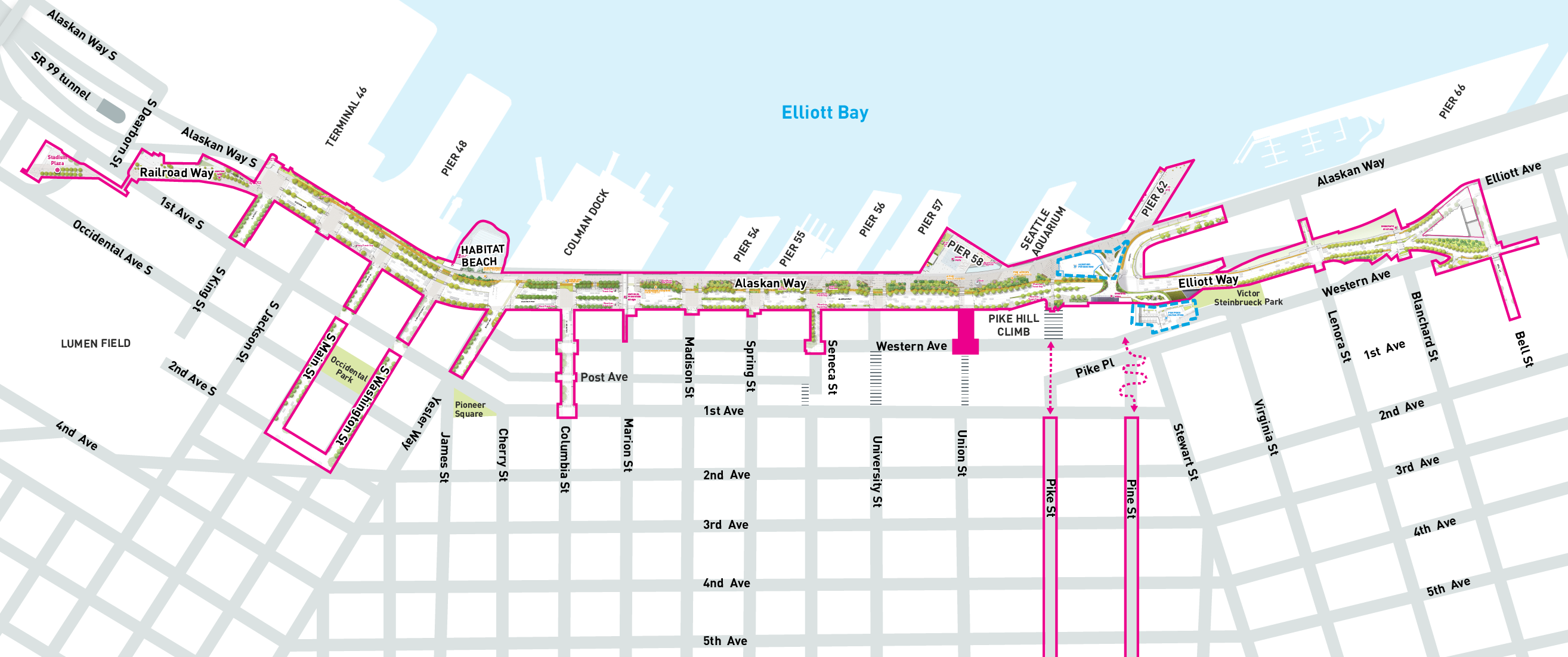Union Street Pedestrian Bridge
PROJECT STATUS

View more images of the opening on the City's Union Street Pedestrian Bridge Flickr Album
PROJECT OVERVIEW
Waterfront Seattle is improving key east-west streets to strengthen connections between downtown and the waterfront. Each of these east-west streets has a unique character, connecting different neighborhoods and opening them up to the new waterfront. The Union Street Pedestrian Bridge is one of these crucial elements in our efforts to reconnect and knit together downtown neighborhoods to the waterfront.
Built on a bluff, traversing Downtown Seattle terrain can be challenging. The new sculpted girder Union Street Pedestrian Bridge, which opened in December 2022, features a grand concrete staircase, accessible elevator for all users, generous elevated walkway, and functional and structurally integral artwork that iconically makes the bridge and public elevator a landmark.
Designed with safety and accessibility in mind, the elevator features well-lit transparent channel glass. The hospital style doors are built for ease of use for wheeled devices. These elements replaced a narrow rudimentary steel switchback stairwell that hugged a retaining wall. Pedestrians then navigated a street end that also served as street access to loading docks for the adjacent businesses. The new bridge and stairs form a gateway entrance to the waterfront and back to downtown. The Bridge project exemplifies the successful collaboration of architects, engineers, city staff, and an artist.
ENHANCING PUBLIC SAFETY THROUGH DESIGN
Environmental design principles were applied to enhance public safety by emphasizing urban and architectural design. This is called Crime Prevention through environmental design (CPTED). Material selection was heavily influenced by visibility and sight lines, future maintainability, and quality, all critical to establishing a comfortable and safe place that attracts public use and ultimately, community ownership.
- The single stanchion cable mesh railing system maximizes transparency and enhances visibility to and from the bridge.
- A transparent elevator cab provides users with a more comfortable experience by being able to see outside and knowing they are visible from the outside.
- Lighting is seamlessly integrated into the handrails to illuminate the walking surface and provide facial and improved visual acuity for recognition of oncoming travelers. The elevator tower is a luminous beacon at night for wayfinding and safety, with fixtures inside at the base of the enclosure and located to minimize light pollution.
The walking surface of the bridge deck and stairs were sand blasted for additional slip resistance and specialty coatings applied at each end of the bridge. Grip rails are integrated into the bridge and stair railing system to provide added comfort to users. A double-sided elevator, sized to accommodate both bicyclists and wheeled mobility devices, was selected to allow for seamless flow of traffic and provides access in a highly visible and activated area.
ART
Integrated art elements create a more positive user experience in the urban infrastructure while creating a visual beacon in the waterfront to indicate the connection.
The project seamlessly integrates artwork to represent a unique collaboration between designers and artist that sets this project apart. Artist Norie Sato worked with the project team to design both an integrated and free-standing artwork. The visual motifs the artist employed in her artwork, titled Unfurling a Gesture (The Nature of Persistence) were informed by the natural environment and manages to make its presence felt on the working waterfront. While performing research on the site, Sato observed a fern growing out of a crack in the side of a building adjacent to the site. She also noted the ubiquity of seagulls. Her project overlays these two representations of the flora and fauna of the waterfront to bring attention to the ecology of shoreline that persists even in the midst of built infrastructure.
Forming a gateway over the stairway leading down from the pedestrian bridge to Alaskan Way, a monumental steel sculpture frames the passageway and serves as a landmark that draws attention to this connection up to Western Avenue. Originally representing a fern, the artwork evokes different interpretations by viewers –some have called it a fishbone, others a feather – and in all cases, - relating back to flora and fauna of the waterfront eco-system. Along the pedestrian walkway at the top of the stairs that connects Western Avenue to the waterfront a long screen shields the view of an adjacent property. The screen depicts both plant imagery – the fern in perforated aluminum – and animal imagery – the wingspan of a seagull in laser-cut stainless-steel. of the bird species so ubiquitous along shorelines.
This publicly sited artwork is not the artist’s first installation in this area: in 1991, Sato created a temporary artwork on the waterfront that marked the location of her arrival to this country by ship. Watch Sato talk about her personal connection to the Seattle waterfront and discuss the varied influences for her work.
Watch a video conversation on Seattle's Waterfront with Artists Norie Sato and Buster Simpson.
RELATED DOCUMENTS
- Union St Flyer March 2021 [PDF, 766 KB]
- Union St Project Completion Flyer December 2022 [PDF, 739 KB]
- Seattle Design Commission presentation
- 90% Seattle Design Commission presentation September 2019 [PDF, 14.2 MB]
AWARDS
- Engineering News-Record (ENR) Northwest Award of Merit - Highway/Bridge 2023
- CMAA Project Achievement Awards Transportation: Construction value less than $10 Million 2023
- 2023 CMAA Project of the Year Northwest Chapter








